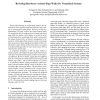Free Online Productivity Tools
i2Speak
i2Symbol
i2OCR
iTex2Img
iWeb2Print
iWeb2Shot
i2Type
iPdf2Split
iPdf2Merge
i2Bopomofo
i2Arabic
i2Style
i2Image
i2PDF
iLatex2Rtf
Sci2ools
115
Voted
ISCA
2012
IEEE
2012
IEEE
Revisiting hardware-assisted page walks for virtualized systems
Recent improvements in architectural supports for virtualization have extended traditional hardware page walkers to traverse nested page tables. However, current twodimensional (2D) page walkers have been designed under the assumption that the usage patterns of guest and nested page tables are similar. In this paper, we revisit the architectural supports for nested page table walks to incorporate the unique characteristics of memory management by hypervisors. Unlike page tables in native systems, nested page table sizes do not impose significant overheads on the overall memory usage. Based on this observation, we propose to use flat nested page tables to reduce unnecessary memory references for nested walks. A competing mechanism to HW 2D page walkers is shadow paging, which duplicates guest page tables but provides direct translations from guest virtual to system physical addresses. However, shadow paging has been suffering from the overheads of synchronization between guest and sh...
Hardware | ISCA 2012 | Page Tables | Page Walker | Xen Hypervisor |
Related Content
| Added | 28 Sep 2012 |
| Updated | 28 Sep 2012 |
| Type | Journal |
| Year | 2012 |
| Where | ISCA |
| Authors | Jeongseob Ahn, Seongwook Jin, Jaehyuk Huh |
Comments (0)

